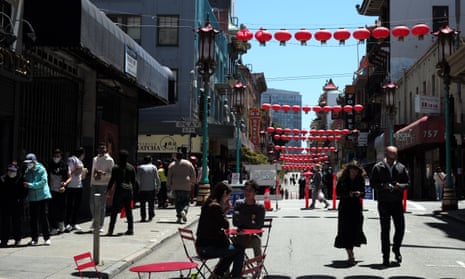San Francisco may have become the first major American city to hit herd immunity to the coronavirus, experts say.
San Francisco is still recording a small number of coronavirus cases, about 13.7 per day, said Dr George Rutherford, professor of epidemiology at University of California San Francisco, but they don’t appear to be gaining enough of a foothold in the population to trigger wider outbreaks.
“That is what herd immunity looks like,” Rutherford said. “You’re going to have single cases, but they’re not going to propagate out.”
Health officials still lack agreement on exactly what percentage of the population must be immune to Covid-19 to achieve the much-vaunted status of “herd immunity”, when so many people have antibodies against the virus that it can no longer spread widely through the community.
Throughout the pandemic, the vaccination goals to hit herd immunity have been a moving target, a briefing from Yale School of Medicine notes, with experts initially estimating that the virus would have difficulty spreading if 60 to 70% of the population was immune. With several variants in circulation, some of which are more contagious, the estimates have been climbing. Many experts now estimate that herd immunity will be achieved when 80 to 90% of residents have been vaccinated.
San Francisco has been close to that target. Nearly 80% of San Francisco residents eligible to receive the coronavirus vaccine have received at least one shot, according to data from the city’s health department, and 68% are fully vaccinated. Among the full population, Asians and Pacific Islanders have even higher vaccination rates than the city average, the stats show, while the Black population lags by about 16 percentage points.
Dr Peter Chin-Hong, an associate dean at UCSF who specializes in infectious diseases, believes when you factor in those who gained immunity from having had the coronavirus, San Francisco already has enough residents with antibodies to have achieved herd immunity. But he said the virus will likely never go away completely in the US.
“I’m hoping that people will still go out and get vaccinated and not rest on their laurels,” he said. “The virus will always be something we need to think about.”
San Francisco has several advantages in its quest for herd immunity, Rutherford noted. The city has few children in its population compared to other places, making a larger percentage of its residents eligible for the vaccine. Its population has been enthusiastic about following Covid safety measures and seeking the vaccine. And it has a compact geography, with a dense community packed into 47sq miles, which has allowed teams of health workers to go door-to-door to reach shut-ins and others who may have trouble getting a vaccination.
“San Francisco has developed a national model for equitable vaccine distribution,” said Mary Ellen Carroll, director of San Francisco’s Department of Emergency Management in a statement announcing the program last month. “Taking vaccine door-to-door and delivering this life saving measure to homebound seniors and people with disabilities will help push San Francisco through the last mile of our vaccine program.”
Chin-Hong noted the city’s history of being at the forefront of the fight against the Aids virus may also have created a trust in health measures that other regions lack.
“San Francisco has this long history of being open-minded and integrating academics and public health with its community and politics,” he said. “Northern California, has been very pro-vaccine and mask wearing has been popular here as well.”
A handful of counties around the country have even higher rates of full vaccination than San Francisco. Those include Hamilton county, New York, where 75% of eligible residents have been fully vaccinated, according to an analysis of data maintained by the New York Times. But none of those counties house a major city.
The state of California, which is preparing to reopen and drop most of its Covid restrictions on 15 June, lags a bit behind San Francisco’s vaccination rate with about 58% of its population having received one dose of the vaccine, according to statistics from the Los Angeles Times. The state has among the highest vaccination rates in the country, but is still behind 11 states including Vermont, Massachusetts and Hawaii.
However, Chin-Hong said the fact that California also had a big outbreak of Covid-19 in the winter means the numbers of immune residents in the state are particularly high.
“California is kind of like Covid safehouse of the US right now,” he said. “When you look at the burden of disease, it’s one of the safest places to be.”
